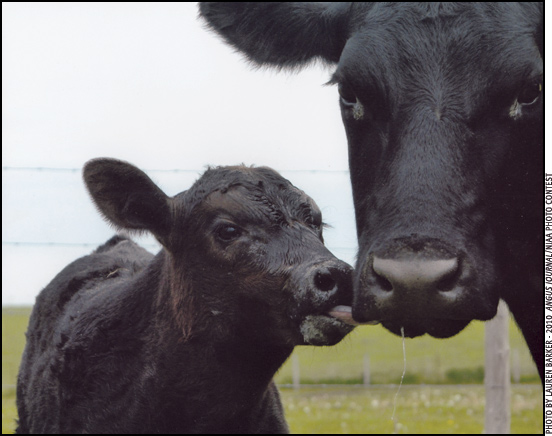
Angus Releases
Heifer Pregnancy EPDs
And, CED EPDs are now enhanced with genomic information.
After years of collecting breeding records, the American Angus Association has introduced a genetic selection tool to help Angus breeders and their customers better identify animals with desirable reproductive ability. The heifer pregnancy expected progeny difference (HP EPD) will measure the chance of a sire's daughters becoming pregnant during a normal breeding season.
"One of our research initiatives has been to characterize reproductive traits in the Angus breed. Now, after much time in the research phase, we've developed a database that allows us to provide EPDs for the reproductive complex," says Bill Bowman, American Angus Association chief operating officer (COO).
The HP EPD isn't a new concept. The Association began reporting research values in its biannual Sire Evaluation Report in 2007. In June 2011, the Association Board of Directors approved moving the HP EPD from research to reality. Beginning July 8, the EPD began appearing weekly alongside other maternal trait EPDs such as calving ease maternal (CEM), maternal milk (Milk), mature weight (MW), mature height (MH) and cow energy value ($EN).
"Angus breeders and their customers continue to recognize the value of selection tools available through the Association," says Sally Northcutt, Association director of genetic research. "The weekly heifer pregnancy evaluation will provide more real-time EPDs for improving the probability of successful heifer breedings in the herd."
HP EPDs are developed using breeding records, pregnancy-check and calving data, as well as pedigree information. The unit of measure for the EPD is a percentage — a higher EPD is more favorable.
"In this case, when comparing two sires on heifer pregnancy EPDs, a higher-EPD sire would be expected to have daughters with a greater probability or chance of becoming pregnant than a sire with the lower EPD," Northcutt explains.
Although reproductive traits are challenging to measure and tend to be more lowly heritable in comparison to growth and carcass traits, Northcutt says the Association is spearheading an aggressive push to expand the breeding database, with first-calf heifers as the initial target for selection tools.
Visit www.angus.org to learn more about heifer pregnancy or other EPDs. The American Angus Association releases National Cattle Evaluation (NCE) EPDs every Friday, providing the most rapidly available selection tools in the beef cattle industry.
CED adds genetic component
On a separate but related note, the calving ease direct (CED) EPD joins AGI's suite of genomic-enhanced selection tools generated using the Association's extensive performance database and genomic results provided by both the High Density 50K (HD 50K) platform from Pfizer Animal Genetics and the Igenity® Profile for Angus.
The CED EPD helps cattlemen predict the average difference in ease with which a sire's calves will be born when he is bred to first-calf heifers. Expressed as a difference in percentage of unassisted births, a higher value indicates greater calving ease in first-calf heifers.
AGI offers genomic-enhanced EPDs for calving ease, carcass, growth (including birth, weaning and yearling weight EPDs; as well as milk) and residual average daily gain (RADG) traits incorporating genomic data from both Pfizer Animal Genetics and Igenity. A genomic-enhanced EPD for docility incorporating Igenity results is also available.
Click here for a complete, regularly updated list of available genomic-enhanced EPDs.
[Click here to go to the top of the page.]












